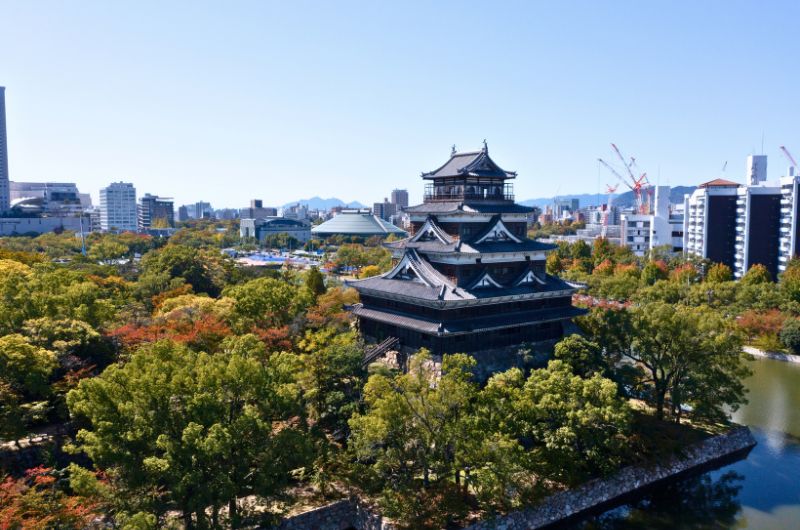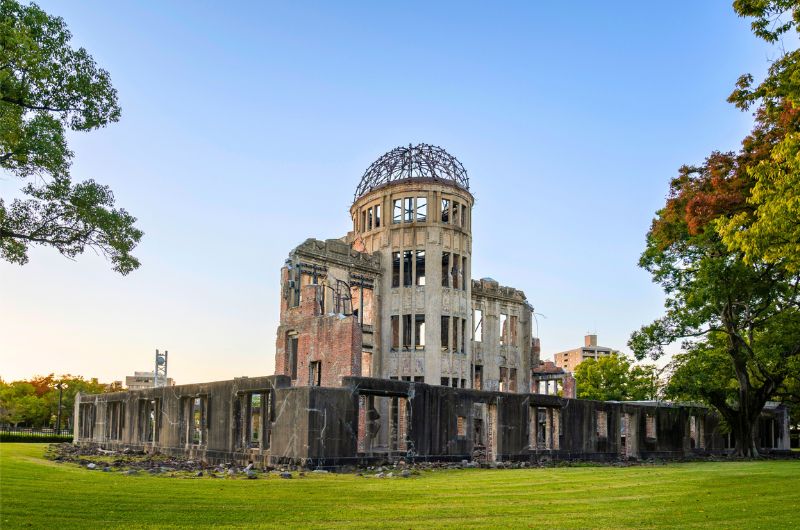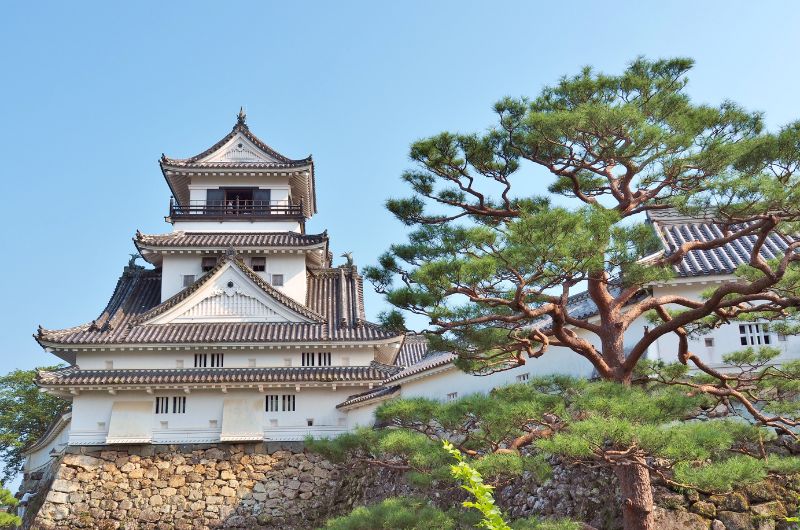Welcome to Japan, a land of serene temples, dazzling neon-lit skyscrapers, and a mouthwatering array of culinary delights. But hold on; there's more to this captivating country than meets the eye.
Japan has a magnetic charm that enchants every kind of traveler, from the curious explorer to the history buff, the foodie to the nature enthusiast. Here, every experience is meticulously crafted, where tradition and innovation dance together, food is an art, history tells captivating tales, the scenery steals your breath, and the people's warmth stays with you long after your journey ends.
Get ready, because this itinerary is designed to make you fall head over heels for Japan.

Best Time to Visit Japan:
Well, it's all about the season, really. Spring, from late March to early May, is a hit with cherry blossoms in full bloom, painting the country in delicate shades of pink, and temperatures ranging from a comfortable 50-70°F (10-21°C).
Fall / Autumn (late September to November) is also a fantastic time to visit, with less crowds than you’ll encounter in the Spring. Visiting in the Fall is your ticket to picturesque golden and amber colored landscapes with temperatures in the same pleasant range as Spring.
Summer (June to August) brings heat and humidity—great for beach lovers, with temperatures soaring to 77–86°F (25-30°C).
Winter (December to February) offers snowy wonderlands, with temperatures often hovering around 32–41°F (0–5°C) or even lower in some regions.
Our favorite time? Anytime between March and November, but specifically Spring and Fall. The shoulder seasons, which fall a month either side of these, are good for travelers looking to avoid crowds at popular locations. Read more about what’s the best time of year to cycle tour Japan here.

1-3 Days in Hiroshima
Nestled along the picturesque shores of the Seto Sea, Hiroshima beckons travelers with its poignant history and serene beauty. Beyond the heart-wrenching tale of resilience, this charming port city showcases its inviting side, offering visitors a chance to explore both its soul-stirring past and its enchanting present. !
How to Get to Onomichi in Hiroshima
In Japan, transportation is a well-oiled machine, with a comprehensive network of trains, buses, and subways that make exploring the country a breeze.
Whether you prefer to fly, take the train, or even catch a bus, getting to Hiroshima is a convenient and accessible journey.
If you're coming from Tokyo, Kyoto, or Osaka, the Shinkansen (bullet train) is your speedy ticket to Hiroshima. Hop on one of these sleek trains, and in a matter of hours, you'll find yourself strolling along the riverside in Hiroshima.

What to Do in Hiroshima:
- Hiroshima Peace Memorial Park and Atomic Bomb Dome: Of course, no visit to Hiroshima is complete without paying your respects at the Hiroshima Peace Memorial Park and Atomic Bomb Dome, a UNESCO World Heritage Site. Here, you'll find a sense of somber tranquility that's hard to describe. The park, a symbol of peace, stands as a testament to the resilience of humanity.
- Explore Miyajima Island: Known as the island where gods reside, Miyajima boasts serene landscapes, historic shrines, and charming, free-roaming deer. Get up close to these gentle creatures as you explore this sacred island on a day trip from Hiroshima.
- Visit the Itsukushima Shrine on Miyajima Island: A UNESCO World Heritage Site, it is a breathtaking example of Shinden-zukuri architecture set against the tranquil backdrop of Miyajima Island.
- Explore the iconic Otorii Gate on Miyajima Island: The gate, believed to be the boundary between the spirit and human worlds, provides a mystical and picturesque setting as it emerges from the sparkling waters of the Seto Inland Sea. It's an experience that encapsulates Japan's aesthetic beauty.
- Learn how to make Hiroshima's renowned Okonomiyaki: Hiroshima is famous for its delectable version of Okonomiyaki, a savory pancake made with a variety of ingredients. You can try your hand at cooking this local specialty and savor the flavors that make it a beloved Hiroshima dish.
Discover the beauty of Shikoku on our all-inclusive bike tour. Plus, kickstart your journey with a pre-tour extension to Hiroshima making the most of your visit to Japan.

1 Day in Onomichi
Positioned along the picturesque Seto Inland Sea in Hiroshima Prefecture, Onomichi exudes the charm of a tranquil harbor town. This coastal gem, scattered across the mainland of Honshu and neighboring islands, offers a nostalgic atmosphere, with small ferries connecting downtown Honshu to the nearby islands. It's also famous as the starting point for the renowned Shimanami Kaido cycling route, making it a must-visit for cycling enthusiasts.
How to Get to Onomichi from Hiroshima
Reaching Onomichi is a breeze, even for first-time visitors. Choose to hop on a scenic train ride or take a comfortable bus journey. Either way, you'll enjoy the picturesque landscapes as you make your way to this charming harbor town.

What to Do in Hiroshima:
- Temple Walk: Onomichi is renowned for its Temple Walk, a serene 1.5 mi (2.5 km) path that meanders through the town, connecting 25 temples, allowing you to soak in the peaceful ambiance and appreciate Japanese culture.
- Pedal the Shimanami Kaido Route: Pedal your way through the iconic Shimanami Kaido route over the Seto Inland Sea, connecting six islands. CNN's travel website has recognized the Shimanami Kaido as one of the "world's top seven cycling routes."
1 Day in Matsuyama
Matsuyama, the largest city in Shikoku, is known for its hot springs, castles, and literature. This city stands out with its unique blend of modern vibrancy and historical charm. Here, colorful orange trams trundle along the main streets, while ancient temples and castles crown the surrounding hills, creating an unforgettable cityscape that's perfect for a one-day adventure.
How to Get to Matsuyama
You can easily reach Matsuyama by train, but one of the best ways is by taking the scenic Shimanami Kaido route by bike. As you pedal past citrus farms, over bridges that offer breathtaking views of the azure Seto Sea, and take in the beauty of the dotted islands, you'll find yourself immersed in the spirit of Shikoku. The route delivers you to the city, perfectly primed for exploration.
For those seeking to savor the beauty of Japan on a bicycle with a little extra assistance, our paddle-assist e-bike promises a seamlessly enjoyable ride through this enchanting land.

What to Do in Matsuyama:
- Pedal the Shimanami Kaido Route: This route is so breathtaking that it deserves to be mentioned twice. As mentioned above, opt to ride your way to Matsuyama through Ikuchi Island, passing the vibrant citrus farms the island is renowned for. The route takes you over a series of bridges, each offering stunning views of the Seto Sea, with islands stretching as far as the eye can see. It's a visual feast that sets the tone for a memorable day.
Shimanami Kaido Route piqued your interest? Read all about it in this Shimanami Kaido Cycling Guide.
- Exploring the City by Tram: Matsuyama is best explored by hopping on the city's iconic orange trams. Not only is it a convenient way to get around, but it's also an opportunity to soak up the local atmosphere.
- Sake Tasting: Enjoy a traditional Japanese dinner with a tasting of Japan's most famous drink, sake. From dry to sweet and everything in between, you'll have the chance to sample a variety of sakes, all while learning about the rich history and cultural significance of this iconic beverage.

2 Days in Yusuhara
Yusuhara, a cozy town in Kochi, Shikoku, is a green paradise cradled by the Shikoku Mountains. It's a place where nature reigns supreme, with a history spanning over a millennium. This town holds its heritage dear, honoring the legacy of the Tsunetaka Fujiwara families who once governed the region. Yusuhara is where nature and history harmonize, creating a unique and welcoming community.
How to Get to Yusuhara
You can travel from Matsuyama to Yusuhara by train or private taxi.

What to Do:
- Marvel at Japanese Architecture: Yusuhara is a canvas of Kengo Kuma's architectural brilliance. As you wander the village, you'll encounter an array of structures and public buildings that showcase his creative genius. It's an architectural treasure hunt you won't want to miss.
- Soak in an Onsen: The day wouldn't be complete without a soothing soak in the Onsen. An Onsen is essentially a Japanese hot spring, but it's so much more than just warm water bubbling from the Earth. These natural geothermal wonders are scattered throughout Japan, as a result of the country's location on the pacific ring of fire. The result? Mineral-rich, warm, and soothing spring water that's not only incredibly relaxing but also believed to have therapeutic benefits.
- Make Traditional Washi Paper: At Kamikoya, a homestead run by the dedicated Rogier, you can explore the world of Washi Paper. The family-run workshops will take you through the entire paper-making process, where you'll get your hands dirty and create your very own unique piece of Washi Paper.

2 Days in Kure Bay
Kure Bay offers the perfect transition from the tranquil mountain village to the dynamic beauty of the Pacific Coast. With kayaking escapades, spiritual exploration, and a date with a vibrant river, it's a coastal paradise you won't want to miss.
How to Get to Kure Bay
There are multiple ways to get to Kure Bay, but we'd argue that the best way is via two wheels. A scenic ride from Matsuyama to Yusuhara takes you on a journey through lush green valleys, nearly deserted roads that are in tip-top condition, and alongside bubbling creeks and rivers; the ideal prelude to your coastal experience.

What to Do in Kure Bay:
- Kayaking: You can meet up with local kayaking enthusiasts who have done their homework and are eager to show you the best spots to take in the local topography from the water. Expect to encounter rocky outcrops and distant mountains that paint a stunning backdrop, and if you're lucky, perhaps some ocean life will make an appearance.
- Iwamoto Temple by Bike:I Take a bike ride to Iwamoto Temple, number 37 on the Henro Pilgrimage route. This serene temple, nestled on a wooded hillside, welcomes you with ornate paintings adorning the ceiling of its main prayer hall. It's a spiritual and visually pleasing experience that's a must-visit.
- Explore Shimanto River: Your Kure Bay adventure isn't complete without a visit to the Shimanto River, a significant fishery and the largest river in the area. As you explore its banks, you'll uncover a unique connection between the locals and this bountiful river.

1 Day in Kochi
Kochi, nestled on Japan's Shikoku Island, is like a well-kept secret and boasts a rich history, with one of Japan's most famous samurai, Ryoma Sakamoto, being born here.
Locals cherish it as a haven known for its pristine natural landscapes, delectable skipjack tuna, and prized yuzu cultivation. It's also a slice of Japan that remains largely untouched by the international tourist crowds.
How to Get to Kochi:
While Kochi can be conveniently reached by plane, private taxi, and train, we wholeheartedly recommend opting for a different kind of journey – one on two wheels. Picture this: Riding through quiet roads that hug the cliffs, the symphony of waves crashing against the striking black rocks below, and the mesmerizing deep blue expanse of the ocean. It's a special experience that’s sure to become a cherished memory. As you pedal through the delightful town of Susaki and make your way to a nature reserve along the ridge, the landscape transforms from exhilarating to tranquil, leaving an indelible mark on your heart and soul.

What to Do in Kochi:
- Visit the 88 Temple Pilgrimage: As you make your way to Kochi, don't miss the chance to stop by the 88 Temple pilgrimage. It stands out as one of the rare circular-shaped pilgrimages across the globe. This spiritual journey comprises 88 "official" temples, along with a myriad of other hallowed sites. These sites hold the essence of Kūkai (Kōbō Daishi), who is believed to have trained and spent time there during the 9th Century.
- Visit Sake Bars: Kochi is known for its unique sake production, and there's no better way to appreciate this Japanese treasure than sampling it in different local watering holes.
- Explore Japanese Castles: Kochi is home to one of Japan's twelve surviving castles, a historical treasure that has weathered fires, wars, and the changing tides of time. Originally constructed in the early 17th century, this castle served as the seat of the Yamauchi lords, who ruled the surrounding region. Today, it houses local treasures, historical artifacts and stands as a testament to a bygone era.

1-3 Days in Kyoto:
Kyoto, a city that carries the echoes of Japan's rich history as a former capital, is a place where heritage and culture continue to thrive amidst the modernization that surrounds it. This is a destination where tradition meets craftsmanship, and there's no shortage of captivating experiences to uncover.
If you opted for a Grasshopper Adventures tour in Japan, your journey would culminate with a train ride back to Kyoto. At this point, you'll have the exciting option to extend your adventure with our Kyoto Spotlight, a fully guided tour designed to help you explore the very best of what Kyoto has to offer.
How to Get to Kyoto:
To get to Kyoto from Kochi, you can take a pleasant 4-hour train journey. As you travel, you'll find yourself leaving behind the serene coastal beauty of Shikoku and transitioning into the cultural heart of Japan.

What to Do in Kyoto:
There is a lot to see and do in Kyoto, so this is by no means a comprehensive list, but here are some worthy ways to enjoy your visit:
- Stroll through Arashiyama Bamboo Forest: If you've been considering a journey to Kyoto, chances are you've come across images of the Arashiyama Bamboo Grove. Yet, no photograph can truly convey the sensation of being amidst this expansive bamboo wonderland. Experience the tranquil beauty of this forest on foot. Walking through this enchanting green landscape is a refreshing and immersive way to connect with Kyoto's natural wonders.
- Sip at Kyoto Beer Lab: This is one of the city's top-rated craft beer pubs. It's a delightful introduction to Kyoto's vibrant food and drink scene, where you can savor handcrafted brews and immerse yourself in the local ambiance.
- Visit Tenryuji Temple: Pay a visit to Tenryuji Temple, a shining example of ancient architecture that has gracefully withstood the test of time. Its tranquil gardens and stunning temple buildings offer a serene escape from the bustle of the city.
- Zen Moments at Ryoanji: Head to Ryoanji in the east, celebrated for its UNESCO-listed zen-style garden, known as "kare-sansui." In this style, you'll find carefully arranged, larger rock formations set amid a bed of smooth pebbles, creating deliberate patterns that are meant to aid in meditation and contemplation.

- Kinkaku-ji Temple: The stunning golden pavilion is a symbol of Kyoto's splendor and provides a picture-perfect moment during your visit.
- Shimogamo-Jinja Sanctuary: Walk through the sacred grounds of Shimogamo-Jinja, one of Kyoto's UNESCO World Heritage Sites. Surrounded by the lush Tadasu no Mori Forest, this shrine is a serene world of greenery and winding streams. It's also home to a small shrine dedicated to the pursuit of beauty.

- Fushimi Inari Hike: And of course, a visit to Kyoto won't be complete without hiking through the iconic red torii gates, leading to the Fushimi Inari Shrine. This mesmerizing tunnel of gates symbolizes good fortune and is a powerful testament to Japanese spirituality.
Wrapping Up Your Japan Adventure
And there you have it – an unforgettable 8-day adventure exploring the wonders of Japan.
Now, it's your turn to pen your Japanese adventure. Why merely imagine the beauty of cherry blossoms or the tranquility of ancient temples when you can witness it firsthand?
Let us take care of all the logistics, so you can fully enjoy your Japan vacation!
 By Lirene Cilliers Posted 14th Nov 2023
By Lirene Cilliers Posted 14th Nov 2023








